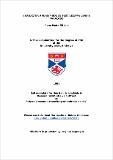Character and symbol in José Lezama Lima's 'Paradiso'
Abstract
This thesis explores the
possibility of some
degree
of unity
in
Paradiso,
which appears
initially to be
a work of poetic self-indulgence,
lacking
a coherent plot, credible characters and causality, and possessing
seemingly extraneous chapters.
In
particular,
the characters, with
their
one shared voice
(Lezama’s)
and apparently arbitrary appearances
in
independent
scenarios,
demand
scrutiny.
Lezama Lima's earlier works are
devoted to his
sistema poético, a
working method aimed at a material representation of
the
mystical world of
the Spirit in the "incarnate Word". Since the
writer
himself has defined
Paradiso
as a novela-poema,
the
novel
is here
examined as a poem, with
the
characters
(recurring
images)
fulfilling
symbolic roles.
Luis Fernández
Sosa’s reading of some of
Lezama’s poems
"anagogically"
(following
the
terminology of
Northrop Frye) is
equally applicable
to Paradiso, with
its
multiple
levels
of meaning.
In Paradiso each act or
incident is
ritualized, suggesting
that the
characters are
indeed
symbolic and may attain
the
stature of archetypes.
Characters derived from
members of
Lezama’s family
circle acquire symbolic
names and
layer
upon
layer
of additional
imagery until
they
are expanded
into
archetypes.
The
recurring
image of
the
(family) tree linking heaven
and earth, continual emphasis on
the cycle of
birth/death/renewal and
the
main configurations, such as
hero/princess/dragon/treasure, assist
in the
identification of
the principal symbolic characters:
Great Mother Goddess,
Son/Lover, Dionysiac sacrifice,
the questing
Orpheus and
the
magnificent
doomed Icarus.
Each
concept or character
is
a stepping-stone
for the central auto-
biographical figure, inspired by
personal
tragedy to
seek self-perfection
and accept
his vocation.
The
stages on
the journey
--family
relationships,
the discovery and mastery of sexuality and creativity,
the pursuit of
infinite knowledge-- are presided over
by
a variety of
tutors, not
least
Rialta, Cemí’s
anima, poetic
Muse
and spiritual guide.
Within Cemí’s heroic
conquest of
the Unconscious, the imagery of
the quest yields much when
interpreted in terms
of
Jungian archetypes.
With his eventual assimilation
of opposites,
Cemí becomes
actively contemplative, attuned
to ritmo
hesicástico and obedient
to his calling.
'The analysis of character
is the
key to Lezama’s fictionalized autobiography, which emerges as a
finely
structured novel given precise
form by its symbolic characters.
Type
Thesis, PhD Doctor of Philosophy
Items in the St Andrews Research Repository are protected by copyright, with all rights reserved, unless otherwise indicated.

